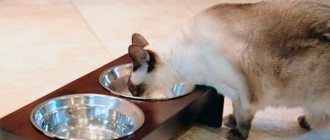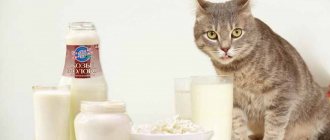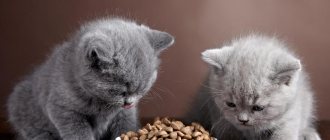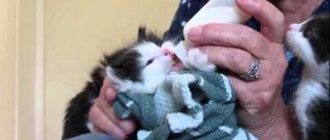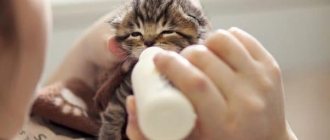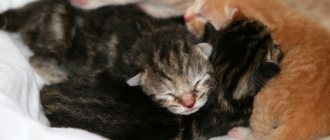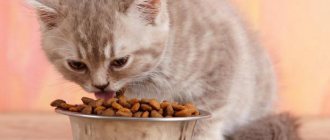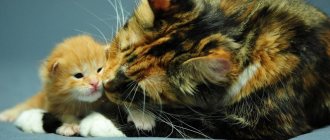The age of a kitten is 3-4 months - this is a rather busy period in the life of a four-legged friend. At this time, the babies usually end up in a new home and move from the breeder to the owner. There is an active growth phase. Muscle development is in full swing. Preparations are underway for the replacement of milk teeth with molars. The kitten is still just as active, spending a lot of strength and energy on understanding the world around him. At 3-4 months, the pet’s body is very vulnerable, as the immunity the kitten received from its mother loses its strength. At this time, the enzyme capable of digesting milk is lost.
In the midst of all these events, it is especially important to protect the kitten from adverse factors. At this stage of a little fluffy’s life, improper feeding can lead to a number of complications: indigestion, improper development of teeth, weakness of the bone and muscle system, etc. To avoid this, it is necessary to provide the kitten with the opportunity to eat properly and in a balanced manner. The diet must meet all the needs of a growing body. By the age of 3-4 months, you need to decide on the type of feeding and stay on it.
Features and rules of feeding
It is necessary to feed a kitten at 3-4 months in accordance with certain rules:
- Meals should be done frequently, but in small portions.
- Feed food at room temperature.
- The diet is enriched with vitamins and minerals. If necessary, we provide them additionally.
- Clean, fresh water is freely available.
- Overeating or undereating should not be allowed. This can cause complications such as developmental delay syndrome if the body does not get enough nutrients and excess weight if the body gets too many nutrients.
- It is necessary to give foods that the kitten will chew, thereby massaging the gums.
Norm and feeding regimen
A kitten at this age does not feel when it is full and has a constant feeling of hunger. To prevent overeating, it is necessary to feed him strictly according to the norm. We feed a three-month-old kitten a daily portion in 5-6 meals. Of these, there may be 3 main meals and 2-3 snacks. Later you can start switching to 4 feedings a day.
The daily food intake at the age of 3-4 months is calculated as 150-200 grams per 1 kg of animal weight. The norm is selected individually, since pets differ in activity and weight. So, for example, for a medium breed kitten at the age of 3 months, 170 grams will be enough, but for a large breed kitten at 4 months, 200 grams may not be enough.
Meal frequency
Three months is the age when the kitten already has milk teeth. He orients himself well in the room and knows the location of bowls of food and water. During this period, babies are separated from their mother and prepared to move to a new family.
The standard weight gain for kittens is 100 grams weekly. Cats are big eaters; when it comes to food, they sometimes do not know when to stop and eat much more food than their body needs. For this reason, it is so important to establish a pet’s diet.
Very small 3-week-old kittens are fed every 2-3 hours. At this age, it is recommended, if possible, to care for babies in the presence of a cat. For older pets, the number of feedings is gradually reduced.
When kittens reach 3-4 months, they begin to be fed 5 times a day. The transition to this power mode is carried out smoothly. If after feeding the baby feels hungry and tries in every possible way to show it, you should not follow his lead and feed him. In such cases, veterinarians recommend giving some food to avoid digestive problems.
By the age of one year, the number of meals in kittens is reduced to three times a day. When changing your pet's feeding regime, do not forget about the individual characteristics of different breeds - a Maine Coon is considered an adult only at the age of three.
How to feed a kitten
At this age, the kitten should eat the same type. This means that you need to stick to feeding either natural food or ready-made food. When moving to a new home, the baby should be kept on his usual diet. When a new owner decides to transfer his four-legged friend to a different type of food, he should start doing this gradually, after a month. This is due to the fact that the kitten needs some time to adapt to new conditions. Next, we’ll look at what to feed a 3-month-old kitten.
Don't forget about the drinking regime. Make sure your kitten always has access to water. When feeding natural food and wet prepared foods, the body's need for water is not high. If you feed your pet mostly dry food, then he needs 2 or even 4 times more water.
Features of kitten development at 3 months
3 months is the time when the baby becomes independent. He is no longer so attached to his mother, he is able to exist without her and does not need care.
If a kitten grew up in a nursery or was raised by volunteers, then at 3 months the developmental features also include:
- Knowledge of the tray;
- Ability to play;
- Proper use of a scratching post;
- Finding out your own nickname.
Street kittens also quickly master these wisdom, provided that the owner has found time to study with the baby.
At 12-13 weeks, character begins to emerge, and it becomes clear what aspects you should pay attention to. It is at this age that it is time to start socializing the “cat-child” and teaching him to adapt to living conditions and to a new owner. The increased curiosity characteristic of a child of this age is inherent in nature. It is impossible to reduce its level; this will affect the psychological development of the pet, but it is important to limit access to places where the pet can be injured.
It is at 3 months that it is necessary to finally decide on the characteristics of the kitten’s diet and stick to it throughout its life, unless the veterinarian recommends adjusting the menu due to a number of diseases.
What to feed a 3 month old kitten
The menu for a 3 month old kitten can be arranged in the following options:
- Natural food specially prepared for the baby;
- Only dry industrial food;
- Pellets combined with a small amount of wet food;
- Only spiders and canned food
Each option has its pros and cons.
Basic rules
Basic recommendations for feeding a kitten at 3 months:
- Compliance with portion sizes and feeding frequency - if the baby does not eat enough, he will grow slowly. An excess of food leads to obesity even at a tender age.
- It is categorically impossible to combine natural food and ready-made food - the animal’s stomach adapts to a certain type, so the combination leads to indigestion.
- New foods should be introduced gradually, carefully monitoring the baby's condition.
- The daily intake must be divided into portions - at 3 months a kitten can eat everything at once, and then remain hungry.
- Canned food and natural food should be warm.
- You should consult your veterinarian about what vitamins and minerals to add to your diet.
- Bowls must be washed regularly and thoroughly.
homemade food
Many owners believe that there is nothing healthier than home-cooked food. However, it is important to remember that the body of a small kitten must receive substances, vitamins and microelements in the required quantities, so each portion should be carefully checked.
If the daily intake is accurately indicated on industrial food, then when feeding natural food the owner will have to do the math on his own. Experts recommend calculating as follows: 100 g per 1 kg of baby’s weight.
At 3 months, the kitten must receive solid food. The increased protein content provides the body with material for growth and energy. Meat also contains taurine, an amino acid that is not produced by the animal’s body. It is urgently needed to maintain the health of the heart muscle and eyes.
Meat products should make up about 70%, the rest - cereals and vegetables. It is permissible to adjust the ratio in case of constipation, when the baby will need more fiber.
IMPORTANT! Natural food is prepared separately for the baby without salt, spices and herbs and has nothing to do with leftovers from lunch or dinner.
Grocery list:
- Frozen veal or beef, thermally processed.
- Turkey and chicken can sometimes replace cow meat, but it is important to remember that chicken often causes allergies. Products also need to be finely chopped and boiled.
- Raw meat in small quantities. Before feeding, you need to freeze it for several days.
- Fermented milk products - it is optimal to buy products from brands designed for children. Required to strengthen teeth and skeletal system.
- It is better to mix vegetables with meat: a very small percentage of kittens agree to eat them in their pure form. Cabbage, zucchini, carrots, pumpkin are useful, preferably raw and grated.
- Buckwheat, semolina and rice, boiled in vegetable broth.
- Chicken yolk - 1-2 times a week with careful monitoring of your health due to the likelihood of an allergic reaction.
- Sea fish - extremely rare and strictly before castration or sterilization.
- A little vegetable oil in vegetables stimulates intestinal motility.
All dishes must be fresh and carefully weighed, in addition, meat trimmings are excluded. Therefore, natural food can cause a lot of trouble, especially since sometimes kittens have a selective taste and eat beef, ignoring vegetables, which are also necessary for development.
Dry food
Many veterinarians recommend it. Main advantages:
- No need to cook or combine foods.
- Easy to use - just pour the desired portion into a bowl.
- The presence of all the necessary elements for development.
However, there are some nuances. Economy class food is useless for the baby. It is almost impossible to find out exactly what it is prepared from; flavorings are added that attract cats, after which it is extremely difficult to switch them to healthier food.
High-quality super-premium and holistic food is quite expensive, however, if there is only one kitten in the house, then the price is quite comparable to the cost of good veal and fresh vegetables without chemicals.
When choosing a brand, you need to pay attention to the composition: it is important that meat products come first, preferably with an exact indication of the percentage in the composition.
You should decide on a brand and not change it unless absolutely necessary: unlike people, cats do not require constant variety.
Dry food can be combined with wet food, but this is done according to the following scheme:
- The daily norm is ¾ dry granules and ¼ canned food.
- It is better to time wet food with evening feeding.
- It is necessary to remove the bowl of dry food 2-3 hours before, if the granules are always freely available.
- It is important to control water consumption - if the animal is not of breed class, then it must be castrated or sterilized. After surgery, they must drink enough fluids to ensure nutrition is absorbed.
IMPORTANT! During the first few days, you need to monitor your baby’s bowel movements and possible vomiting. If the latter occurs, as well as constipation, diarrhea, streaks of blood, the food must be replaced.
Wet food
The option of feeding only spiders or canned food is possible. This is the most expensive method, however, it provides the cat with enough fluid. Such a solution should be resorted to on the recommendation of a doctor, or if the baby categorically refuses to eat dry food. It is possible to accustom your pet to the latter, but it requires significant persistence and time.
When choosing wet food as a base, it is also important to study the composition and choose the brand. All canned food is divided into complete and “additional”. The latter are not used as the main food. You need to make sure that the chosen brand and type contains all the substances your baby needs and you can limit yourself to just that.
Water
Water should always be freely available for the kitten. For kids it is better to warm it up a little. Teaching a kitten to drink is quite simple:
- Bowls should be placed in different places in the house or apartment;
- It is important that drinking containers are kept away from the food bowl;
- In addition to standard large bowls, you should use non-standard containers, including mugs and children's buckets - the baby's curious nose will definitely end up inside, and at the same time the kitten will drink;
- The water should be renewed at the slightest contamination, after rinsing the container.
Some kittens and adult cats watch the flowing stream of water in fascination and try to drink straight from the tap. For these, it is worth buying a drinking fountain: the baby will be busy playing or watching, and also drink the necessary liquid.
Natural nutrition
Natural feeding can be called nutrition that is balanced using a number of products.
Thus, meat, fish, and eggs are considered protein foods. Fats are found in egg yolks, offal and butter. Carbohydrates can be replenished with cereals: buckwheat, rice, oatmeal.
Include foods that are approved for feeding to cats in your diet. When introducing a new component into your diet, pay attention to your stool. Eating foods containing salt, pepper, as well as fried and spicy foods is strictly prohibited.
Pros of natural feeding:
- The owner knows for certain what he feeds the pet.
- Natural composition.
Disadvantages of natural feeding:
- You need knowledge, and most importantly time to cook.
- Food spoils quickly.
- Additionally, it is necessary to give vitamins and minerals.
When compiling a natural diet for what to feed a kitten at 3-4 months, you need to include the following products:
- Lean meat (beef, poultry, rabbit), always well cooked.
- Cottage cheese or yogurt without additives, low-fat or with the lowest percentage of fat content.
- Vegetables and fruits (carrots, pumpkin, zucchini, cabbage, green apples, cucumber and more).
- Porridge with water or meat broth.
- Egg yolk or whole quail eggs.
- Liver and sea fish, but not more than once a month.
What not to feed a kitten
Some owners who do not know how to properly feed kittens give them foods that are undesirable for consumption.
- Salted, fried, smoked, peppered, spicy, fatty. These foods cause inflammation of the digestive tract.
- Milk. At the age of 3-4 months, it is better to give it up, since the kitten’s digestive tract is no longer able to digest lactose.
- Citrus. They are not digestible in cats. Moreover, they cause irritation of the mucous membrane of the stomach and esophagus, which leads to an attack of vomiting followed by dehydration.
- Bones. Cats chew bones into many fragments, which pass through the gastrointestinal tract and injure the mucous membrane. As a result, bleeding may occur.
- Chocolate and other sweets. They have a toxic effect on the kitten’s body.
- Vegetables of the nightshade family, as well as onions and garlic. The body does not digest these foods.
- Avocado, grapes and raisins. They contain a poisonous toxin.
Ready-made feed
The composition of industrial feeds is already balanced. This diet is enriched with vitamin and mineral supplements necessary for the development of the kitten. There are dry and wet food. When feeding, it is better to give preference to one type of food. If you still decide to use both dry and wet food, then separate them and feed them at different meals.
Advantages of ready-made feed:
- Convenience. Such food saves time that would have to be spent on cooking.
- The feed is already balanced.
- When eating dry food, the kitten actively works with its jaws, which puts the necessary load on the entire oral apparatus. This stimulation promotes proper development of the jaw muscles and bones.
- Among the ready-made foods there is a large selection of lines according to the tastes and physiological state of the pet.
Disadvantages of ready-made feeds:
- High quality feed has a high cost.
- It is difficult to choose food among a large number of different brands.
- Dependence on economy-class flavor enhancers is developing.
Rules for feeding a 3 month old kitten dry food:
- Feed should be given in accordance with the norm indicated on the package.
- The food must correspond to the type of animal, its age and physiological condition.
- It is better to feed the same brand and line of food.
- When feeding dry food, clean water should be nearby.
- Food should not sit in a bowl; such food becomes of poor quality.
Acana
Canadian-made food belongs to the super-premium class. The composition is good, does not contain cereals. Fresh (8%) and raw (8%) meat, fresh whole eggs (8%), as well as dehydrated poultry (8%), and offal are used as a source of protein. The total amount of protein products is 35%. There are useful ingredients such as: apple, pear, cranberry, brown algae, carrots, pumpkin and others.
Only dry food with fish, lamb and chicken flavors is available for sale.
The feeding rate for kittens 5-20 weeks is 60 grams per kg of weight.
Royal Canin
Premium food. The protein content in wet food is 10-12%, and in dry food 36%. The protein in this food is mainly vegetable. Excess amount of carbohydrates. There are also corn flour, dry beet pulp, and soybean components.
This brand of food contains mainly poultry meat. Royal Canin brand food is presented in the form of canned pates, wet and dry ready-made food.
For babies aged three months, you should choose Royal Canin MOTHER&BABYCAT food - this food is perfect for feeding kittens from 1 to 4 months. For a four-month-old kitten, Royal Canin Kitten food is suitable. This food can be fed to kittens from 4 to 12 months.
During the day, the baby will need 50-65 g and 55-70 g, respectively.
Bosch Sanabelle Kitten
This food belongs to the same class as Royal Canin. The composition contains all the necessary components. Fresh poultry meat – 25%, fresh liver – 5%. The composition is enriched with fiber, eggs, animal fats, calcium supplements and brewer's yeast. Also in the list of ingredients there are those that can cause allergies - these are maize and cellulose.
Kittens can eat this food for up to a year, and it is also suitable for pregnant and lactating cats. You can choose either dry food or wet food.
The feeding rate is 55-60 g and 60-65 g, respectively.
What can you give?
At three months, active growth of babies begins. At this age, their teeth are changing and they need solid food. You can feed your pets with dry and wet food and natural products.
Dry food
Today, there are many varieties of dry food on the shelves in pet stores and veterinary clinics - for adult cats and kittens, for different breeds, and others. Sometimes you come across options with fennel and probiotics in the composition. They reduce gas formation in kittens. There are no special rules for feeding dry food to furry pets. The main thing is not to feed more than the daily norm per day and provide your pet with constant access to fresh water. Portion rates, depending on the age and weight of the kitten, are indicated on the packaging.
It is very important not to violate the recommendations for the size of food portions. Kittens are very active, they run around the apartment all day long and play, expending a lot of energy. Even with high energy costs, regular overeating can lead to excess weight gain and metabolic disorders. Your baby should be introduced to dry food gradually to avoid mechanical damage to the digestive system. At first, it is recommended to soak the granules in water.
Wet food
At three months, babies are ready to chew and digest adult food. They can be fed the following foods:
- Cooked or raw meat with low fat content. If the product is given raw, it must first be frozen. It is easier for kittens to digest veal or chicken.
- By-products - chicken liver or necks. They can be given to babies 2-3 times a week.
- Boiled quail eggs. Of chicken, only the yolk is allowed for consumption.
- Kefir, fermented baked milk and other low-fat fermented milk products.
- Cereals and porridges from which it is preferable to cook in meat broth.
- Vegetables.
- Boiled white fish without bones.
- Sprouted herbs - oats, wheat. They can be grown at home in a pot.
The diet can be varied with wet cat food, which is sold in cans or pouches.
Prohibited Products
Some products are prohibited for consumption not only for babies, but also for adult cats. These include the following:
- whole milk - as animals age, the amount of enzymes in their bodies that are responsible for the breakdown of lactose decreases;
- high fat dairy products;
- river fish species;
- spices, sugar and salt;
- pork and lamb;
- potato;
- beans.
Veterinarians do not recommend feeding kittens table scraps. Any products are prohibited - sausage, flour, fried foods.
